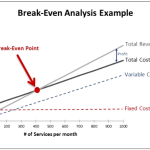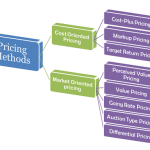Price determination is one of the most crucial aspects in economics. Business managers are expected to make perfect decisions based on their knowledge and judgment. Since every economic activity in the market is measured as per price, it is important to know the concepts and theories related to pricing. Pricing discusses the rationale and assumptions behind pricing decisions. It analyzes unique market needs and discusses how business managers reach upon final pricing decisions.
It explains the equilibrium of a firm and is the interaction of the demand faced by the firm and its supply curve. The equilibrium condition differs under perfect competition, monopoly, monopolistic competition, and oligopoly. Time element is of great relevance in the theory of pricing since one of the two determinants of price, namely supply depends on the time allowed to it for adjustment.
Market Structure
A market is the area where buyers and sellers contact each other and exchange goods and services. Market structure is said to be the characteristics of the market. Market structures are basically the number of firms in the market that produce identical goods and services. Market structure influences the behavior of firms to a great extent. The market structure affects the supply of different commodities in the market.
When the competition is high there is a high supply of commodity as different companies try to dominate the markets and it also creates barriers to entry for the companies that intend to join that market. A monopoly market has the biggest level of barriers to entry while the perfectly competitive market has zero percent level of barriers to entry. Firms are more efficient in a competitive market than in a monopoly structure.
Perfect Competition
Perfect competition is a situation prevailing in a market in which buyers and sellers are so numerous and well informed that all elements of monopoly are absent and the market price of a commodity is beyond the control of individual buyers and sellers
With many firms and a homogeneous product under perfect competition no individual firm is in a position to influence the price of the product that means price elasticity of demand for a single firm will be infinite.
Pricing Decisions
Determinants of Price Under Perfect Competition
Market price is determined by the equilibrium between demand and supply in a market period or very short run. The market period is a period in which the maximum that can be supplied is limited by the existing stock. The market period is so short that more cannot be produced in response to increased demand. The firms can sell only what they have already produced. This market period may be an hour, a day or a few days or even a few weeks depending upon the nature of the product.
Market Price of a Perishable Commodity
In the case of perishable commodity like fish, the supply is limited by the available quantity on that day. It cannot be stored for the next market period and therefore the whole of it must be sold away on the same day whatever the price may be.
Market Price of Non-Perishable and Reproducible Goods
In case of non-perishable but reproducible goods, some of the goods can be preserved or kept back from the market and carried over to the next market period. There will then be two critical price levels.
The first, if price is very high the seller will be prepared to sell the whole stock. The second level is set by a low price at which the seller would not sell any amount in the present market period, but will hold back the whole stock for some better time. The price below which the seller will refuse to sell is called the Reserve Price.
Monopolistic Competition
Monopolistic competition is a form of market structure in which a large number of independent firms are supplying products that are slightly differentiated from the point of view of buyers. Thus, the products of the competing firms are close but not perfect substitutes because buyers do not regard them as identical. This situation arises when the same commodity is being sold under different brand names, each brand being slightly different from the others.
For example − Lux, Liril, Dove, etc.
Each firm is therefore the sole producer of a particular brand or “product”. It is monopolist as far as a particular brand is concerned. However, since the various brands are close substitutes, a large number of “monopoly” producers of these brands are involved in a keen competition with one another. This type of market structure, where there is competition among a large number of “monopolists” is called monopolistic competition.
In addition to product differentiation, the other three basic characteristics of monopolistic competition are −
● There are large number of independent sellers and buyers in the market.
● The relative market shares of all sellers are insignificant and more or less equal. That is, seller-concentration in the market is almost non-existent.
● There are neither any legal nor any economic barriers against the entry of new firms into the market. New firms are free to enter the market and existing firms are free to leave the market.
● In other words, product differentiation is the only characteristic that distinguishes monopolistic competition from perfect competition.
Monopoly
Monopoly is said to exist when one firm is the sole producer or seller of a product which has no close substitutes. According to this definition, there must be a single producer or seller of a product. If there are many producers producing a product, either perfect competition or monopolistic competition will prevail depending upon whether the product is homogeneous or differentiated.
On the other hand, when there are few producers, oligopoly is said to exist. A second condition which is essential for a firm to be called monopolist is that no close substitutes for the product of that firm should be available.
From above it follows that for the monopoly to exist, following things are essential −
● One and only one firm produces and sells a particular commodity or a service.
● There are no rivals or direct competitors of the firm.
● No other seller can enter the market for whatever reasons legal, technical, or economic.
● Monopolist is a price maker. He tries to take the best of whatever demand and cost conditions exist without the fear of new firms entering to compete away his profits.
The concept of market power applies to an individual enterprise or to a group of enterprises acting collectively. For the individual firm, it expresses the extent to which the firm has discretion over the price that it charges. The baseline of zero market power is set by the individual firm that produces and sells a homogeneous product alongside many other similar firms that all sell the same product.
Since all of the firms sell the identical product, the individual sellers are not distinctive. Buyers care solely about finding the seller with the lowest price.
In this context of “perfect competition”, all firms sell at an identical price that is equal to their marginal costs and no individual firm possess any market power. If any firm were to raise its price slightly above the market-determined price, it would lose all of its customers and if a firm were to reduce its price slightly below the market price, it would be swamped with customers who switch from the other firms.
Accordingly, the standard definition for market power is to define it as the divergence between price and marginal cost, expressed relative to price. In Mathematical terms we may define it as −
L =
(P − MC)P
Oligopoly
In an oligopolistic market there are small number of firms so that sellers are conscious of their interdependence. The competition is not perfect, yet the rivalry among firms is high. Given that there are large number of possible reactions of competitors, the behavior of firms may assume various forms. Thus there are various models of oligopolistic behavior, each based on different reactions patterns of rivals.
Oligopoly is a situation in which only a few firms are competing in the market for a particular commodity. The distinguishing characteristics of oligopoly are such that neither the theory of monopolistic competition nor the theory of monopoly can explain the behavior of an oligopolistic firm.
Two of the main characteristics of Oligopoly are briefly explained below −
● Under oligopoly the number of competing firms being small, each firm controls an important proportion of the total supply. Consequently, the effect of a change in the price or output of one firm upon the sales of its rival firms is noticeable and not insignificant. When any firm takes an action its rivals will in all probability react to it. The behavior of oligopolistic firms is interdependent and not independent or atomistic as is the case under perfect or monopolistic competition.
● Under oligopoly new entry is difficult. It is neither free nor barred. Hence the condition of entry becomes an important factor determining the price or output decisions of oligopolistic firms and preventing or limiting entry of an important objective.
For Example − Aircraft manufacturing, in some countries: wireless communication, media, and banking.


